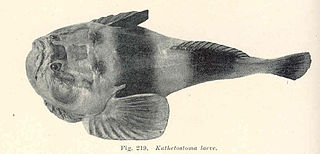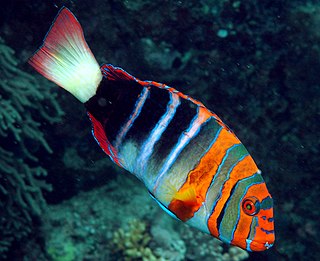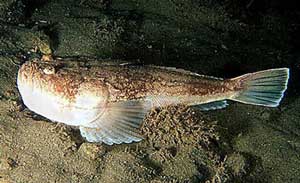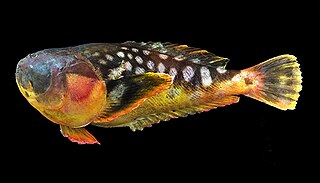
The stargazers are a family, Uranoscopidae, of perciform fish that have eyes on top of their heads. The family includes about 51 species in eight genera, all marine and found worldwide in shallow and deep saltwaters.

Bodianus or the hogfishes is a genus of fish in the family Labridae found in the Atlantic, Indian and Pacific Ocean. These species have many parasites.

Choerodon is a genus of wrasses native to the Indian Ocean and the western Pacific Ocean. They are commonly referred to as tuskfish, because most species have sharp tusk-like teeth.
Asymbolus is a genus of catsharks in the family Pentanchidae, the deepwater catsharks.

Urolophus is a genus of round rays mostly native to the western Pacific Ocean and the Indian Ocean, though one species occurs in the Pacific waters of the Mexican coast. Müller and Henle erected Urolophus in an 1837 issue of Bericht Akademie der Wissenschaften zu Berlin. The name is derived from the Greek oura, meaning "tail", and lophos, meaning "crest". In Urolophus, the outer rims of the nostrils are not enlarged into lobes, but may form a small knob at the back.
Dactyloscopus is a genus of sand stargazers native to the coasts of the Americas.

A bottom feeder is an aquatic animal that feeds on or near the bottom of a body of water. Biologists often use the terms benthos—particularly for invertebrates such as shellfish, crabs, crayfish, sea anemones, starfish, snails, bristleworms and sea cucumbers—and benthivore or benthivorous, for fish and invertebrates that feed on material from the bottom. However the term benthos includes all aquatic life that lives on or near the bottom, which means it also includes non-animals, such as plants and algae. Biologists also use specific terms that refer to bottom feeding fish, such as demersal fish, groundfish, benthic fish and benthopelagic fish. Examples of bottom feeding fish species groups are flatfish, eels, cod, haddock, bass, grouper, carp, bream (snapper) and some species of catfish and sharks.

Coastal fish, also called inshore fish or neritic fish, inhabit the sea between the shoreline and the edge of the continental shelf. Since the continental shelf is usually less than 200 metres (660 ft) deep, it follows that pelagic coastal fish are generally epipelagic fish, inhabiting the sunlit epipelagic zone. Coastal fish can be contrasted with oceanic fish or offshore fish, which inhabit the deep seas beyond the continental shelves.

Lepidotrigla is a genus of marine ray-finned fishes belonging to the family Triglidae, the gurnards and sea robins. These gurnards are found in the Eastern Atlantic, Indian and Western Pacific Oceans.
Dactyloscopus moorei, also known as the speckled stargazer, is a species of sand stargazer native to the Atlantic and Gulf coasts of the United States. From North Carolina to Texas it can be found on sandy bottoms at depths of from 3 to 35 metres. This species can reach a length of 8 centimetres (3.1 in) TL. The specific name honours the American archaeologist Clarence Bloomfield Moore (1852-1936).

Uranoscopus is a genus of stargazer fish from the family Uranoscopidae. The name Uranoscopus is from the Greek, ouranos, "sky" and skopein, "to watch".

Hoplostethus is a genus of fish in the slimehead family.

Brachysomophis cirrocheilos, also known as the stargazer snake eel, is a benthic marine fish belonging to the family Ophichthidae. The stargazer snake eel is a large fish which grows up to 159 cm (63 in) long.

Oxycheilinus is a genus of fish in the family Labridae found in the Indian and Pacific Ocean.
Crapatalus is a genus of southern sandfishes native to the coastal waters of Australia and New Zealand.
Crapatalus munroi, the robust pygmy stargazer or Munro's Pygmy-stargazer, is a species of demersal marine ray-finned fish from the family Leptoscopidae. It is found in southern Australia from the Gippsland Lakes in Victoria to the Great Australian Bight in South Australia and south to the D'Entrecasteaux Channel in Tasmania. It occurs in shallow water over pale coloured sand, where it buries itself in the substrate. The specific name honours the Australian ichthyologist Ian Stafford Ross Munro who discovered the species.

Ichthyscopus is a genus of stargazers from the family Uranoscopidae. They are ambush predators from the western Indo-Pacific region.

Kathetostoma is a genus of bony fish from the family Uranoscopidae, the stargazers. They are demersal predators which are found in the western Atlantic, Pacific and Indian Oceans, with most species around Australia and New Zealand.

The deepwater stargazer is a ray-finned fish species in the stargazer family, described in 1915. It is native to the Eastern Indian Ocean.













